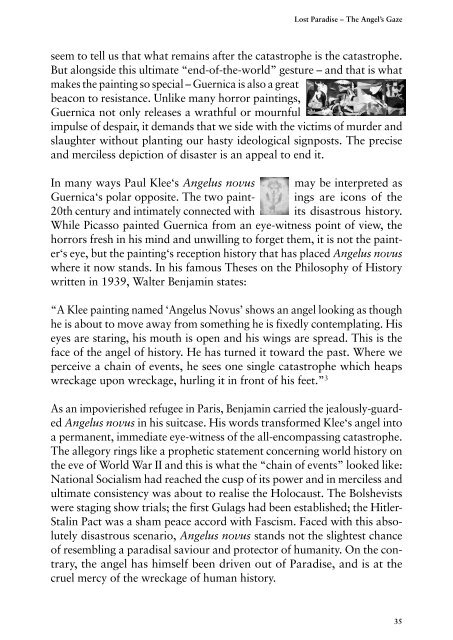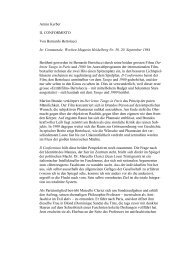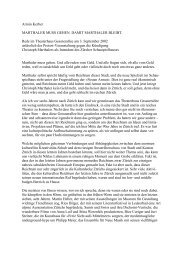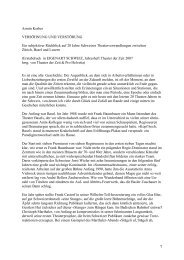You also want an ePaper? Increase the reach of your titles
YUMPU automatically turns print PDFs into web optimized ePapers that Google loves.
<strong>Lost</strong> <strong>Paradise</strong> – The Angel’s Gaze<br />
seem to tell us that what remains after the catastrophe is the catastrophe.<br />
But alongside this ultimate “end-of-the-world” gesture – and that is what<br />
makes the painting so special – Guernica is also a great<br />
beacon to resistance. Unlike many horror paintings,<br />
Guernica not only releases a wrathful or mournful<br />
impulse of despair, it demands that we side with the victims of murder and<br />
slaughter without planting our hasty ideological signposts. The precise<br />
and merciless depiction of disaster is an appeal to end it.<br />
In many ways Paul Klee‘s Angelus novus may be interpreted as<br />
Guernica‘s polar opposite. The two paint- ings are icons of the<br />
20th century and intimately connected with its disastrous history.<br />
While Picasso painted Guernica from an eye-witness point of view, the<br />
horrors fresh in his mind and unwilling to forget them, it is not the painter‘s<br />
eye, but the painting‘s reception history that has placed Angelus novus<br />
where it now stands. In his famous Theses on the Philosophy of History<br />
written in 1939, Walter Benjamin states:<br />
“A Klee painting named ‘Angelus Novus’ shows an angel looking as though<br />
he is about to move away from something he is fixedly contemplating. His<br />
eyes are staring, his mouth is open and his wings are spread. This is the<br />
face of the angel of history. He has turned it toward the past. Where we<br />
perceive a chain of events, he sees one single catastrophe which heaps<br />
wreckage upon wreckage, hurling it in front of his feet.” 3<br />
As an impovierished refugee in Paris, Benjamin carried the jealously-guarded<br />
Angelus novus in his suitcase. His words transformed Klee‘s angel into<br />
a permanent, immediate eye-witness of the all-encompassing catastrophe.<br />
The allegory rings like a prophetic statement concerning world history on<br />
the eve of World War II and this is what the “chain of events” looked like:<br />
National Socialism had reached the cusp of its power and in merciless and<br />
ultimate consistency was about to realise the Holocaust. The Bolshevists<br />
were staging show trials; the first Gulags had been established; the Hitler-<br />
Stalin Pact was a sham peace accord with Fascism. Faced with this absolutely<br />
disastrous scenario, Angelus novus stands not the slightest chance<br />
of resembling a paradisal saviour and protector of humanity. On the contrary,<br />
the angel has himself been driven out of <strong>Paradise</strong>, and is at the<br />
cruel mercy of the wreckage of human history.<br />
35









